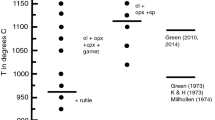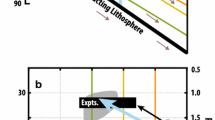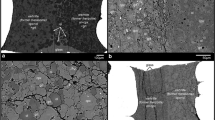Abstract
We use the results of elevated pressure melting experiments to constrain the role of melt/mantle reaction in the formation of tholeiitic magma from Kilauea volcano, Hawaii. Trace element abundance data is commonly interpreted as evidence that Kilauea tholeiite is produced by partial melting of garnet lherzolite. We experimentally determine the liquidus relations of a tightly constrained estimate of primary tholeiite composition, and find that it is not in equilibrium on its liquidus with a garnet lherzolite assemblage at any pressure. The composition is, however, cosaturated on its liquidus with olivine and orthopyroxene at 1.4 GPa and 1425 °C, from which we infer that primary tholeiite is in equilibrium with harzburgite at lithospheric depths beneath Kilauea. These results are consistent with our observation that tholeiite primary magmas have higher normative silica contents than experimentally produced melts of garnet lherzolite. A model is presented whereby primary tholeiite forms via a two-stage process. In the first stage, magmas are generated by melting of garnet lherzolite in a mantle plume. In the second stage, the ascent and decompression of magmas causes them to react with harzburgite in the mantle by assimilating orthopyroxene and crystallizing olivine. This reaction can produce typical tholeiite primary magmas from significantly less siliceous garnet lherzolite melts, and is consistent with the shift in liquidus boundaries that accompanies decompression of an ascending magma. We determine the proportion of reactants by major element mass balance. The ratio of mass assimilated to mass crystallized (Ma/Mc) varies from 2.7 to 1.4, depending on the primary magma composition. We use an AFC calculation to model the effect of melt/harzburgite reaction on melt rare earth and high field strength element abundances, and find that reaction dilutes, but does not significantly fractionate, the abundances of these elements. Assuming olivine and orthopyroxene have similar heats of fusion, the Ma/Mc ratio indicates that reaction is endothermic. The additional thermal energy is supplied by the melt, which becomes superheated during adiabatic ascent and can provide more thermal energy than required. Melt/harzburgite reaction likely occurs over a range of depths, and we infer a mean depth of 42 km from our experimental results. This depth is well within the lithosphere beneath Kilauea. Since geochemical evidence indicates that melt/harzburgite reaction likely occurs in the top of the Hawaiian plume, the plume must be able to thin a significant portion of the lithosphere.
Similar content being viewed by others
Author information
Authors and Affiliations
Additional information
Received: 4 February 1997 / Accepted: 27 August 1997
Rights and permissions
About this article
Cite this article
Wagner, T., Grove, T. Melt/harzburgite reaction in the petrogenesis of tholeiitic magma from Kilauea volcano, Hawaii. Contrib Mineral Petrol 131, 1–12 (1998). https://doi.org/10.1007/s004100050374
Issue Date:
DOI: https://doi.org/10.1007/s004100050374




